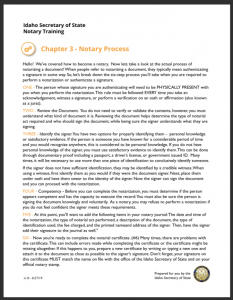Idaho Secretary of State
Notary Training
![]()
Training Video
Training Transcript
 Chapter 3 – Notary Process
Chapter 3 – Notary Process
Hello! We’ve covered how to become a notary. Now lets take a look at the actual process of notarizing a document! When people refer to notarizing a document, they typically mean authenticating a signature in some way. So, let’s break down the six-step process you’ll take when you are required to perform a notarization or authenticate a signature.
ONE – The person whose signature you are authenticating will need to be PHYSICALLY PRESENT with you when you perform the notarization. This rule must be followed EVERY time you take an acknowledgement, witness a signature, or perform a verification on an oath or affirmation (also known as a jurat).
TWO – Review the Document. You do not need to verify or validate the contents, however, you must understand what kind of document it is. Reviewing the document helps determine the type of notarial act required and who should sign the document, while being sure the signer understands what they are signing.
THREE – Identify the signer. You have two options for properly identifying them – personal knowledge or satisfactory evidence. If the person is someone you have known for a considerable period of time and you would recognize anywhere, this is considered to be personal knowledge. If you do not have personal knowledge of the signer, you must use satisfactory evidence to identify them. This can be done through documentary proof including a passport, a driver’s license, or government issued ID. Many times, it will be necessary to use more than one piece of identification to conclusively identify someone.
If the signer does not have sufficient identification, they may be identified by a credible witness. When using a witness, first identify them as you would if they were the document signer. Next, place them under oath and have them swear to the identity of the signer. Now the signer can sign the document and you can proceed with the notarization.
FOUR – Competency – Before you can complete the notarization, you must determine if the person appears competent and has the capacity to execute the record. You must also be sure the person is signing the document knowingly and voluntarily. As a notary, you may refuse to perform a notarization if you do not feel confident the signer meets these requirements.
FIVE – At this point, you’ll want to add the following items in your notary journal: The date and time of the notarization, the type of notarial act performed, a description of the document, the type of identification used, the fee charged, and the printed nameand address of the signer. Then, have the signer add their signature to the journal as well.”
SIX – Now you’re ready to complete the notarial certificate. (#6) Many times, there are problems with the certificate. This can include errors made while completing the certificate or the certificate might be missing altogether. If this happens to you, prepare a new certificate by writing or typing a new one and attach it to the document as close as possible to the signer’s signature. Don’t forget, your signature on this certificate MUST match the name on file with the office of the Idaho Secretary of State and on your official notary stamp.
v1.0 – 6/27/19


